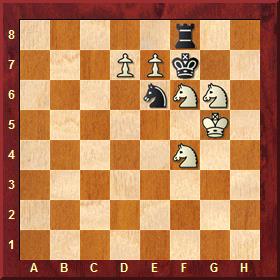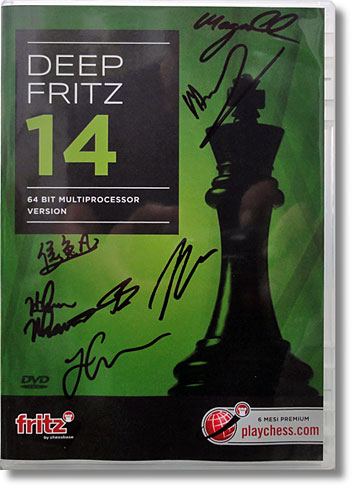


In a previous article, I introduced the concept of ‘chess constructs’ which are basically an intermediate form of composition or chess problem that lies somewhere between real game sequences and traditional award-winning compositions. A construct has a stipulation, is economical, is interesting or educational, and of some aesthetic merit. It is not constrained by adherence to traditional composition conventions and is simple enough to be composed by average players and amateur composers. It does not try or need to be ‘too clever’. Part of an interesting game you once played could be the inspiration for a good construct that others can also easily enjoy.
ChessBase was kind enough to sponsor a contest inviting readers to compose their own construct and for me to judge them. A total of 14 submissions were received over the two-week period of the contest. Fig. 1 below shows the winner, the first and the second runner-up. Solutions are provided at the end of the article.
Winner: Roland Kensdale
ChessBase Chess Construct Contest July 2014

White to play and mate in three
|
First Runner-Up: Z. Mendlowitz
ChessBase Chess Construct Contest July 2014  White to play and mate in three |
Second Runner-up: Henk van der Velde
ChessBase Chess Construct Contest July 2014  White to play and mate in three |
Constructs are generally easier to solve than traditional award-winning compositions because they tend to resemble real games more. The reader might notice that the winner of this contest is a position that actually starts with White being in check: sacrilege of a major traditional composition convention, yet a notable difference between constructs and traditional compositions.
It is also no coincidence across all domains (real games, constructs, traditional compositions) that knights tend to feature more prominently than other pieces when it comes to chess aesthetics. Perhaps it has something to do with their unique and often-overlooked movement style. The constructs above won because they met all the basic criteria specified in the previous article, exhibited creativity and aesthetics, and were not too complicated or cumbersome for the average player to enjoy and learn from. Below are two more constructs submitted as ‘worthy mentions’.
|
First Worthy Mention: Roland Kensdale
ChessBase Chess Construct Contest July 2014  White to play and mate in three |
Second Worthy Mention: Henk van der Velde
ChessBase Chess Construct Contest July 2014  White to play and mate in three |
The worthy mentions above did not make the top three, but they are still good examples of constructs that do not require line upon line of variations analysis to properly fathom. The solution is simple, direct and clear. The variations can be figured out as easily as one might be able to do in a real game. They also feature structures and substructures that one is more likely to come across and remember in an actual game.
I would like to thank all those who took the time to compose a valid construct for submission. I would also like to thank ChessBase for providing you with incentives for doing so. Enjoy your prizes. I hope to write more on the subject of constructs in the near future so stay tuned.

Select games from the dropdown menu above the board

The first prize was a Fritz 14 chess program signed by most of the best players in the world – the participants of the 2014 Zurich Chess Challenge (Carlsen, Aronian, Nakamura, Caruana, Anand, Gelfand, and as a bonus Hou Yifan. The award goes to Roland Kensdale. The runner-up prizes – a Fritz Trainer of their choice – go to Z. Mendlowitz and Henk van der Velde. Please send us your choices and addresses.
6/29/2014 – Azlan Iqbal: Introducing ‘Chess Constructs’
People love brilliancies from chess history – and artistic chess problems. But there is a big gap between the two. Positions from games demonstrate the natural beauty of actual play, while chess problems are highly technical, with little practical relevance. The author of this interesting article suggest an intermediate form, one you can try your hand at – and win a prize in the process.
9/2/2009 – Can computers be made to appreciate beauty?
Or at least to identify and retrieve positions that human beings consider beautiful? While computers may be able to play at top GM level, they are not able to tell a beautiful combination from a bland one. This has left a research gap which Dr Mohammed Azlan Mohamed Iqbal, working at Universiti Tenaga Nasional, Malaysia, has tried to close. Here's his delightfully interesting PhD thesis.
12/15/2012 – A computer program to identify beauty in problems and studies
Computers today can play chess at the grandmaster level, but cannot tell a beautiful combination from a bland one. In this research, which has been on-going for seven years, the authors of this remarkable article show that a computer can indeed be programmed to recognize and evaluate beauty or aesthetics, at least in three-move mate problems and more recently endgame studies. Fascinating.
2/2/2014 – A new, challenging chess variant
Ever since desktop computers can play at its highest levels and beat practically all humans, the interest of the Artificial Intelligence community in this game has been sagging. That concerns Dr Azlan Iqbal, a senior lecturer with a PhD in AI, who has created a variant of the game that is designed to rekindle the interest of computer scientists – and be enjoyable to humans as well: Switch-Side Chain-Chess.